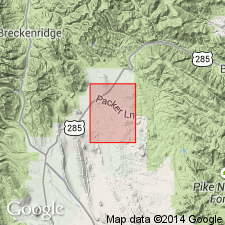
- Usage in publication:
-
- South Park Formation*
- Modifications:
-
- Named
- Geochronologic dating
- Dominant lithology:
-
- Sandstone
- Tuff
- Conglomerate
- Mudstone
- AAPG geologic province:
-
- South Park basin
Summary:
Named for South Park, Park Co, CO, the type area. Lies in South Park basin. First named in an unpublished thesis by Sawatzky (1967, Colorado School of Mines). Divided into (ascending order): 1) Reinecker Ridge Volcanic Member (new), a unit composed of andesite porphyry flows, breccias, and conglomerate; 2) conglomeratic member composed of conglomerate and sandstone; 3) Link Spring Tuff Member composed of waterlaid tuff, breccia, andesite, and conglomerate; and 4) arkosic member composed of arkosic sandstone, conglomerate, and mudstone. Is about 10,000 ft (3,050 m) thick. Rests unconformably on Laramie Formation or on Fox Hills Sandstone. Is unconformably overlain by Wall Mountain Tuff 12 mi south of quad. Well preserved fossil leaves of Paleocene age in middle and lower part. A date of 56.8 +/-2 m.y. by whole rock analysis obtained from Reinecker Ridge, and a date of 58.4 +/-2.0 m.y. on biotite obtained from Link Spring. Rocks of the South Park were assigned to Shoshone Formation or to Denver? Formation in earlier reports.
Source: GNU records (USGS DDS-6; Denver GNULEX).
For more information, please contact Nancy Stamm, Geologic Names Committee Secretary.
Asterisk (*) indicates published by U.S. Geological Survey authors.
"No current usage" (†) implies that a name has been abandoned or has fallen into disuse. Former usage and, if known, replacement name given in parentheses ( ).
Slash (/) indicates name conflicts with nomenclatural guidelines (CSN, 1933; ACSN, 1961, 1970; NACSN, 1983, 2005, 2021). May be explained within brackets ([ ]).

